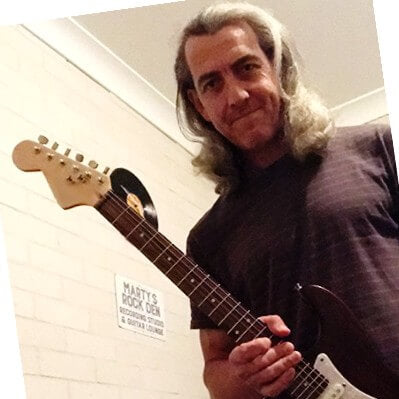EXP-style DIY Guitar Kit Review
Interested in learning how to build your own EXP-style guitar? In the following article, we’re going to dive into the history of this legendary guitar and some of the artists that have played them. We’ll also discuss building your own DIY EXP style guitar, including timber, pickups, wiring, and finishing.
A shape like no other
If you consider the most iconic electric guitar body shapes, for example, the Gibson® Les Paul® and SG® or the Fender® Stratocaster® and Telecaster®, all of these shapes tend to stick within a predictable design framework. That being the rounded, figure 8 shape all guitars have evolved from overtime since Spanish Luthier Antonio Torres Jurado first standardized the shape of the classical guitar back in 1850.
This same design was then leaned on heavily when the first acoustic steel string guitars were developed, and naturally when the first electric guitars began to appear in the 1930s.
These body shapes are more or less synonymous with the electric guitar and share some fairly obvious similarities e.g. the wider lower bout, narrow waist and upper bout consisting of a single-cutaway as per the Les Paul® and Telecaster® or the double-cutaway/horn shape of the legendary Stratocaster® and SG®.
The modernist series
But, back in 1958, Gibson®, in an attempt to change the game somewhat introduced the ‘modernist' series. This was an attempt to break from tradition and 'modernize' electric guitar design in response to the success of the Fender® Stratocaster®, first introduced in 1954, which although shared the same ‘figure 8’ stylings, was considered a departure from the more traditional guitar shapes that preceded it.
Most electric guitars up to this point were influenced heavily by acoustic guitar design, however acoustic guitar design was based as much on how the body shape influenced the tonal output and volume of the guitar as it was for comfort and aesthetics. In simple terms, as electric guitars rely on amplification to produce sound and shape the tone of the instrument more than the materials and methods used in construction, this loyalty to traditional design was no longer essential.
What followed was the revolutionary ‘Flying V®’ and the ‘Explorer®’, along with the less known ‘Moderne®’. These shapes were considered revolutionary at the time, with their angular shapes, straight lines, and hard edges, not to mention the Explorer®’s hockey stick headstock design, which was an update to the original run of split headstock shapes featuring 3 tuners on each side. However, they were not well received when first released.
Considering in 1959 Gibson® only managed to sell 3 Explorers®, it’s fair to say the design was ahead of its time and was shelved in 1960 until 1976 when Gibson® noticed other manufacturers (Hamer (Standard), Ibanez (Destroyer)) were using this same design, and the rest, as they say, is history.
Along with Hamer and Ibanez, the Explorer-style body shape has since been utilized by a number of notable guitar manufacturers including:
- Dean (Kelly)
- ESP (MX220 and MX250)
- Greco (EX800)
- Aria Pro II (ZZ Deluxe)
- Cort (Effector)
- Kramer (Explorer)
- Peavey (Rotor EX)
- Chapman (Ghost Fret)
Artists who played the Explorer®
Any metalhead worth their salt will immediately conjure up images of James Hetfield of Metallica when thinking of famous Explorer® players. Hetfield has used Explorers almost exclusively throughout his career with the exception of Metallica’s first release ‘Kill em all’ in 1983 which, coincidently he mostly recorded with a Gibson® Flying V®.
Other notable guitarists who played Explorers include:
- Allen Collins - Lynyrd Skynyrd
- Eric Clapton - (Fun fact - Eric Clapton’s original 58 Explorer® was auctioned off for approx. $130,000)
- Gary Moore
- Eddie Van Halen (Ibanez Destroyer)
- The Edge (U2)
- Rick Nielsen (Cheap Trick)
- Billy Gibbons (ZZ Top)
- Dave Grohl (Foo Fighters)
Build your own EXP-shaped DIY guitar
The EXP could be considered one of the easier to assemble DIY electric guitar kits with simple wiring, and the option for either set or bolt-on neck. The flat body and straight lines also make sanding and finishing a breeze compared to the more rounded contours of the ST or hollow body kits.
If you have never assembled or finished an electric guitar before, the EXP-style kit makes for a good starting point. In fact, we have a complete run-through showing all of the steps involved in assembly right here: EXP Guitar Kit Assembly Manual.
Summing Things Up
The EXP guitar kit represents one of the most famous and revolutionary electric guitar shapes of all time and considering the simplicity of the design is also one of the easiest to assemble.
Also Read: PR-style Guitar Kit Review
Like all of the guitars listed on the site, you can select from the left and right-hand options along with a full range of custom options including timber species, fretboard material, and hardware color if you're ordering from our Custom Shop.
We also offer in-stock EXP-style kits which you can find from here.

